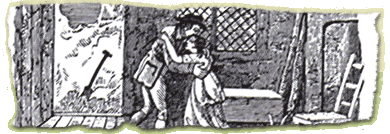

The Poor Old Weaver's Daughter
Poverty,
Money
Archival information
Lyrics
1
As I rode out one May morning across yon fields so early,
I spied a maid, a most beautiful maid, as sweet as any fairy.
Said I, “My pretty maid, where art thou going?” And by the hand I took her.
She blushed and she said, “I’m going home, I’m a poor old weaver’s daughter.”
2
“May I come with thee, my pretty maid, for gold and silver I’ve plenty?”
She turned her head, she blushed and she said, “Oh no, kind sir, I thank thee.
My mother she is dead and lay in her grave and the early lesson she taught me,
Was to marry for love and not for gold,” cried that poor old weaver’s daughter.
3
“My father is old and is nearly blind and almost past his labour,
It would break his heart for us to part for he’s been such a good old master,
So parted from him I never shall be for he’s been such a good kind father,
So until he’s laid in his peaceful grave I’m a poor old weaver’s daughter.”
4
“Fare-thee-well, fare-thee-well, my own pretty maid, may thy prospects ever be brighter,
And the lad thou loves shall be constant and true, and happily you’ll be united;
For friendship’s sake this gold ring take.” What a lovely maid I thought her,
And as long as I live I never shall forget that poor old weaver’s daughter.
This is a traditional song
Provenance
The earliest text we have seen of this song was printed in the early nineteenth century by Pitts and Catnach in London and Swindells in Manchester. This version differs enough in text from the mid nineteenth century Lancashire printings of Bebbington and Harkness to suggest the later version was taken from oral tradition. Roger’s version from his father’s singing appears to be the only full version from oral tradition. George ‘Pop’ Maynard of Sussex sang two-and-a-half stanzas and the same can be found in Alfred Williams’ Folk Songs of the Upper Thames, p191 from the early years of the twentieth century in Gloucestershire. As one would expect Roger’s version is textually closer to the later Lancashire broadsides than the earlier ones.
Such sentimental occupational pieces were part of the stock repertoires of the London pleasure gardens of the late eighteenth century. A similar much more popular piece The Garden Gate, also a favourite of the Hinchliffes, came from the pleasure gardens and was widely printed on broadsides.

